Packaged bakery food company Flower Foods (NYSE:FLO) reported results in line with analysts' expectations in Q1 CY2024, with revenue up 2.8% year on year to $1.58 billion. On the other hand, the company's full-year revenue guidance of $5.13 billion at the midpoint came in slightly below analysts' estimates. Its non-GAAP profit of $0.38 per share was flat year on year.
Flowers Foods (FLO) Q1 CY2024 Highlights:
- Revenue: $1.58 billion vs analyst estimates of $1.58 billion (small miss)
- Adjusted EBITDA: $159.4 million vs analyst estimates of $168.2 million (5.2% miss)
- EPS (non-GAAP): $0.38 vs analyst expectations of $0.41 (6.2% miss)
- The company reconfirmed its revenue guidance for the full year of $5.13 billion at the midpoint (slightly below expectations)
- The company reconfirmed its EPS (non-GAAP) guidance for the full year of $1.25 at the midpoint (slightly above expectations)
- Gross Margin (GAAP): 49.4%, up from 47.8% in the same quarter last year
- Free Cash Flow of $71.82 million, up 19.7% from the previous quarter
- Sales Volumes were down 0.8% year on year
- Market Capitalization: $5.39 billion
With Wonder Bread as its premier brand, Flower Foods (NYSE:FLO) is a packaged foods company that focuses on bakery products such as breads, buns, and cakes.
The company traces its roots back to 1919, when brothers William Howard and Joseph Hampton Flowers commenced their operations with a single bakery and initially sold fresh bread directly to customers from a horse-drawn wagon. The company subsequently grew through organic means as well as through acquisitions, with the 2013 acquisition of Wonder Bread from Hostess as a notable one
Today, some notable products include Nature’s Own Whole Wheat and Honey Wheat Bread, Dave’s Killer Bread, Tastykake cupcakes and donuts, and Mrs. Freshley’s brownies and cakes. Flowers Foods’ core customer is the everyday American household. From the parent packing school lunches to the college student looking for a quick snack, their products have widespread appeal. Recognizing the evolving dietary needs and preferences of consumers, Flowers Foods has diversified its product range, including healthier bread options and organic choices.
The company’s baked goods can be found in many locations selling food and snacks. Wonder Bread and Flower Foods’ other brands are available in supermarkets, convenience stores, and mass retailers. Additionally, a significant portion of their products are sold to foodservice and vending companies.
Perishable Food
The perishable food industry is diverse, encompassing large-scale producers and distributors to specialty and artisanal brands. These companies sell produce, dairy products, meats, and baked goods and have become integral to serving modern American consumers who prioritize freshness, quality, and nutritional value. Investing in perishable food stocks presents both opportunities and challenges. While the perishable nature of products can introduce risks related to supply chain management and shelf life, it also creates a constant demand driven by the necessity for fresh food. Companies that can efficiently manage inventory, distribution, and quality control are well-positioned to thrive in this competitive market. Navigating the perishable food industry requires adherence to strict food safety standards, regulations, and labeling requirements.
Competitors in packaged bakery goods include Grupo Bimbo (BMV:BIMBO A), Hostess Brands, acquired by J.M. Smucker (NYSE:SJM), and Pepperidge Farm, a subsidiary of Campbell Soup (NYSE:CPB).Sales Growth
Flowers Foods is larger than most consumer staples companies and benefits from economies of scale, giving it an edge over its smaller competitors.
As you can see below, the company's annualized revenue growth rate of 5.7% over the last three years was mediocre for a consumer staples business.
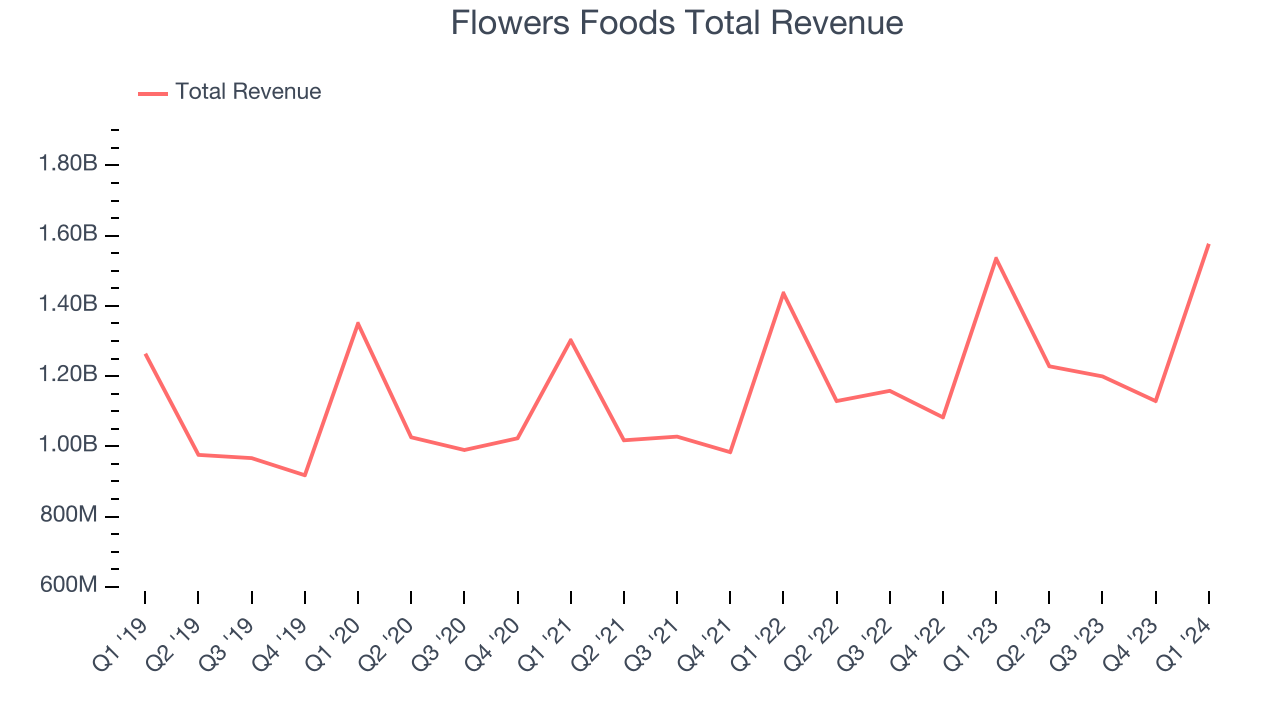
This quarter, Flowers Foods's revenue grew 2.8% year on year to $1.58 billion, falling short of Wall Street's estimates. Looking ahead, Wall Street expects revenue to remain flat over the next 12 months, a deceleration from this quarter.
Volume Growth
Revenue growth can be broken down into changes in price and volume (the number of units sold). While both are important, volume is the lifeblood of a successful staples business as there’s a ceiling to what consumers will pay for everyday goods; they can always trade down to non-branded products if the branded versions are too expensive.
Flowers Foods's average quarterly volume growth was a healthy 3.3% over the last two years. This is pleasing because it shows consumers are purchasing more of its products.
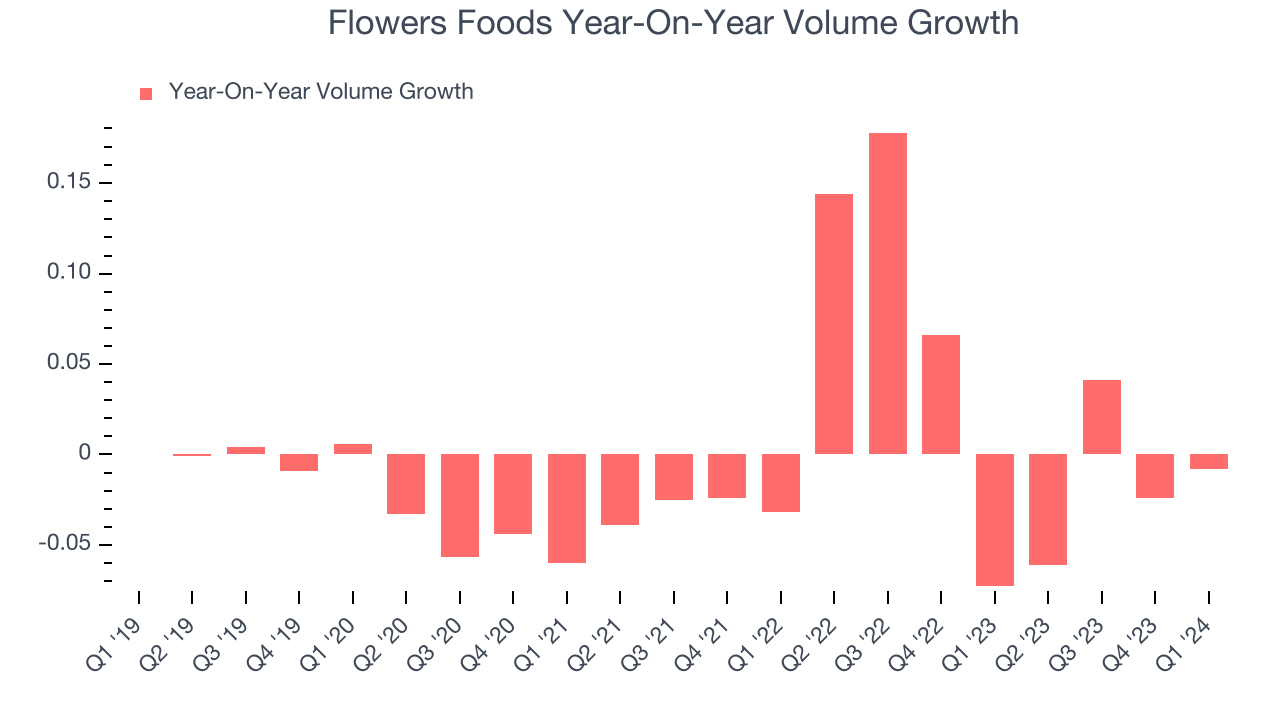
In Flowers Foods's Q1 2024, year on year sales volumes were flat. This result was a well-appreciated turnaround from the 7.3% year-on-year decline it posted 12 months ago, showing the company is heading in the right direction.
Gross Margin & Pricing Power
All else equal, we prefer higher gross margins. They usually indicate that a company sells more differentiated products and commands stronger pricing power.
Flowers Foods's gross profit margin came in at 49.4% this quarter, up 1.6 percentage points year on year. That means for every $1 in revenue, $0.51 went towards paying for raw materials, production of goods, and distribution expenses.
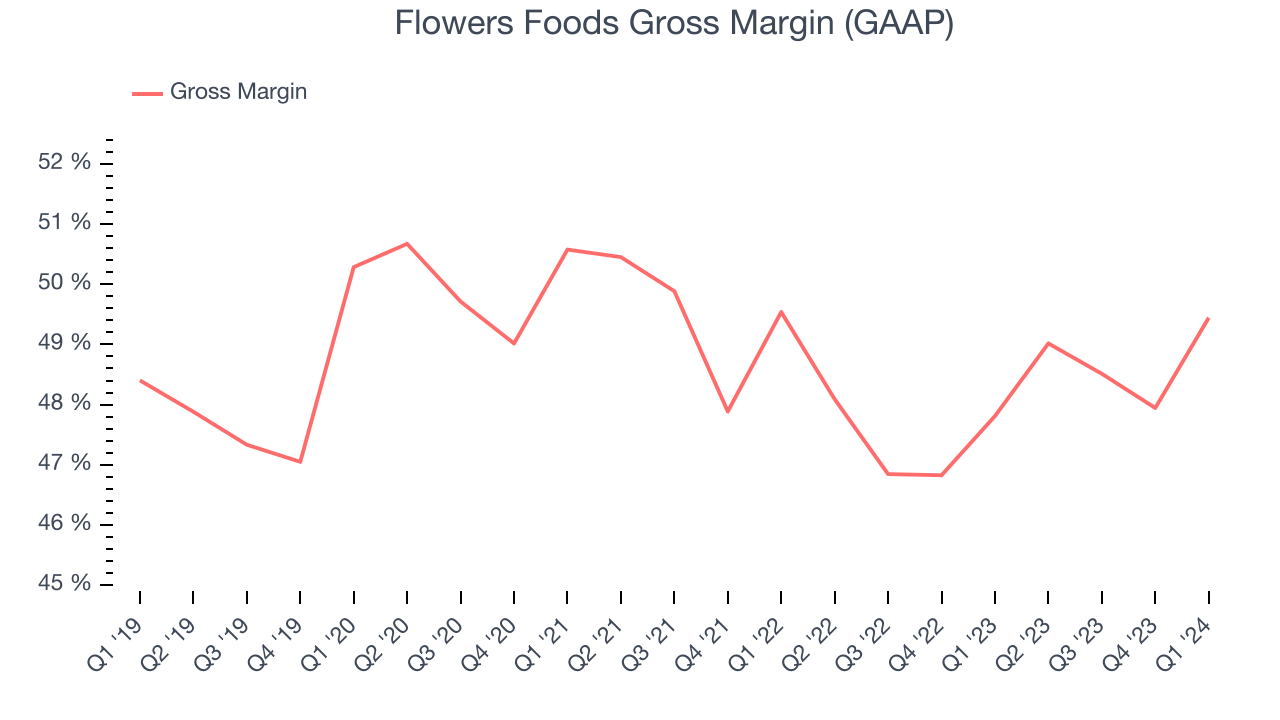
Flowers Foods has great unit economics for a consumer staples company, giving it ample room to invest in areas such as marketing and talent to grow its brand. As you can see above, it's averaged an impressive 48.1% gross margin over the last eight quarters. Its margin has also been trending up over the last 12 months, averaging 2.8% year-on-year increases each quarter. If this trend continues, it could suggest a less competitive environment where the company has better pricing power and more favorable input costs (such as raw materials).
Operating Margin
Operating margin is a key profitability metric for companies because it accounts for all expenses enabling a business to operate smoothly, including marketing and advertising, IT systems, wages, and other administrative costs.
In Q1, Flowers Foods generated an operating profit margin of 6.4%, in line with the same quarter last year. This indicates the company's costs have been relatively stable.
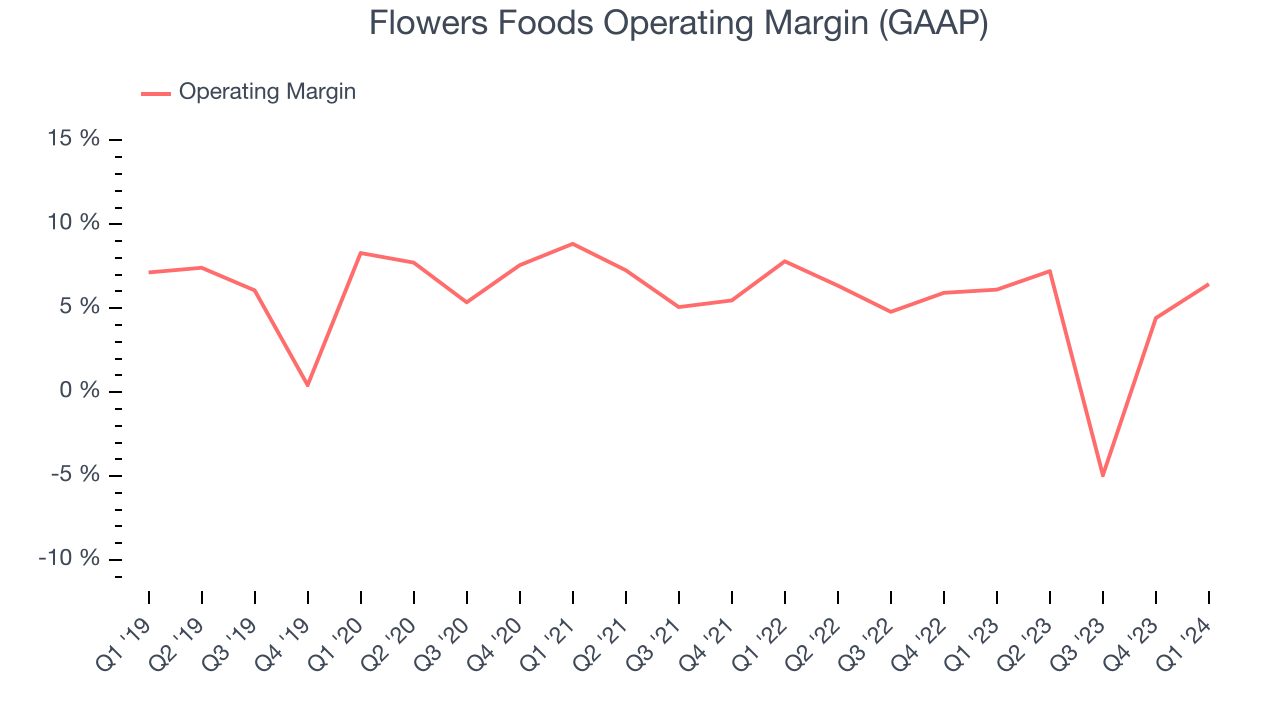 Zooming out, Flowers Foods was profitable over the last two years but held back by its large expense base. It's demonstrated mediocre profitability for a consumer staples business, producing an average operating margin of 4.6%. On top of that, Flowers Foods's margin has declined by 2.3 percentage points on average over the last year. This shows the company is heading in the wrong direction, and investors are likely hoping for better results in the future.
Zooming out, Flowers Foods was profitable over the last two years but held back by its large expense base. It's demonstrated mediocre profitability for a consumer staples business, producing an average operating margin of 4.6%. On top of that, Flowers Foods's margin has declined by 2.3 percentage points on average over the last year. This shows the company is heading in the wrong direction, and investors are likely hoping for better results in the future.EPS
These days, some companies issue new shares like there's no tomorrow. That's why we like to track earnings per share (EPS) because it accounts for shareholder dilution and share buybacks.
In Q1, Flowers Foods reported EPS at $0.38, in line with the same quarter a year ago. This print unfortunately missed Wall Street's estimates, but we care more about long-term EPS growth rather than short-term movements.
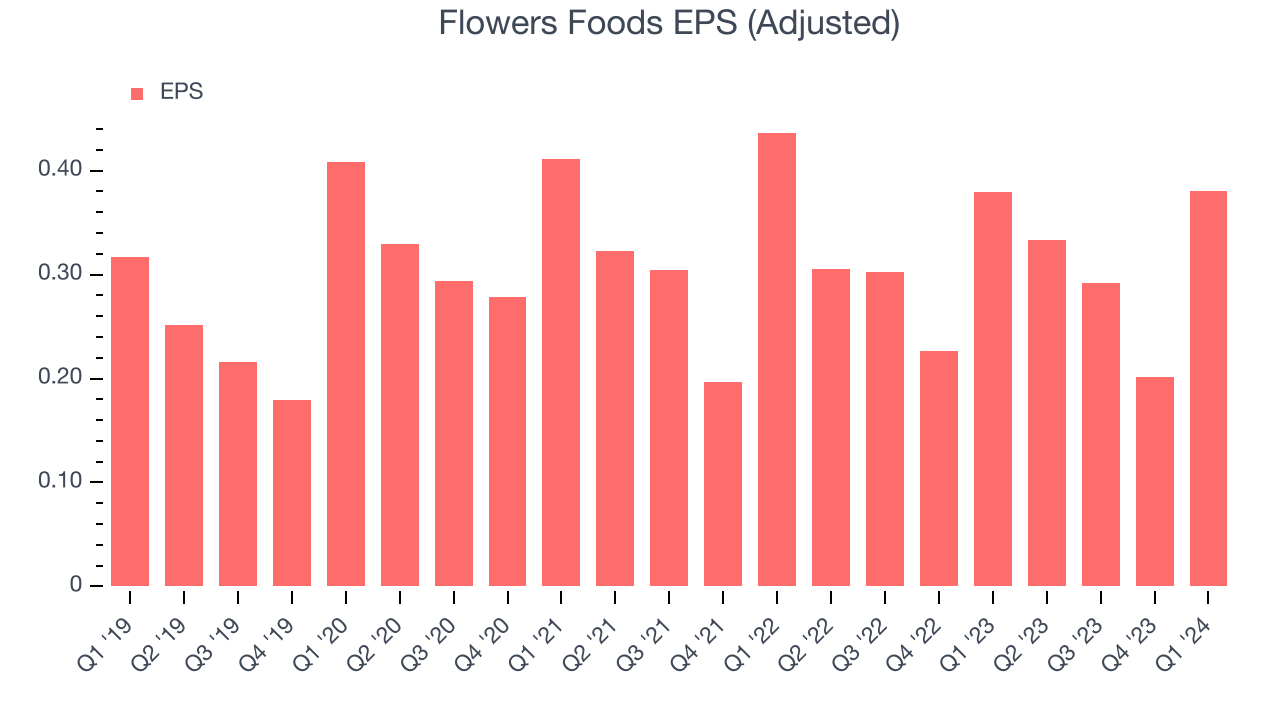
Between FY2021 and FY2024, Flowers Foods's EPS dropped 8.2%, translating into 2.8% annualized declines. We tend to steer our readers away from companies with falling EPS, especially in the consumer staples sector, where shrinking earnings could imply changing secular trends or consumer preferences. If there's no earnings growth, it's difficult to build confidence in a business's underlying fundamentals, leaving a low margin of safety around the company's valuation (making the stock susceptible to large downward swings).
On the bright side, Wall Street expects the company's earnings to grow over the next 12 months, with analysts projecting an average 3.6% year-on-year increase in EPS.
Cash Is King
If you've followed StockStory for a while, you know we emphasize free cash flow. Why, you ask? We believe that in the end, cash is king, and you can't use accounting profits to pay the bills.
Flowers Foods's free cash flow came in at $71.82 million in Q1, up 198% year on year. This result represents a 4.6% margin.
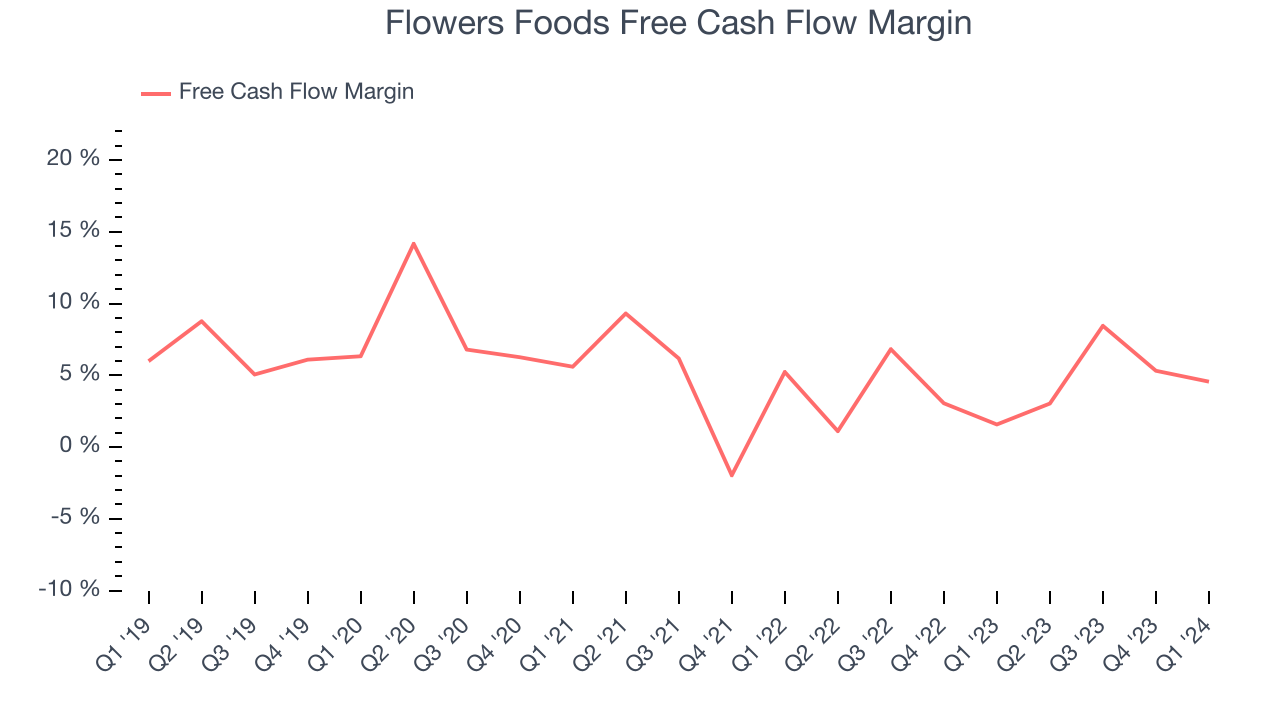
Over the last eight quarters, Flowers Foods has shown mediocre cash profitability, putting it in a pinch as it gives the company limited opportunities to reinvest, pay down debt, or return capital to shareholders. Its free cash flow margin has averaged 4.2%, subpar for a consumer staples business. However, its margin has averaged year-on-year increases of 2.2 percentage points over the last 12 months. Continued momentum should improve its cash flow prospects.
Return on Invested Capital (ROIC)
EPS and free cash flow tell us whether a company was profitable while growing revenue. But was it capital-efficient? A company’s ROIC explains this by showing how much operating profit a company makes compared to how much money the business raised (debt and equity).
Flowers Foods's five-year average ROIC was 9.8%, somewhat low compared to the best consumer staples companies that consistently pump out 20%+. Its returns suggest it historically did a subpar job investing in profitable business initiatives.
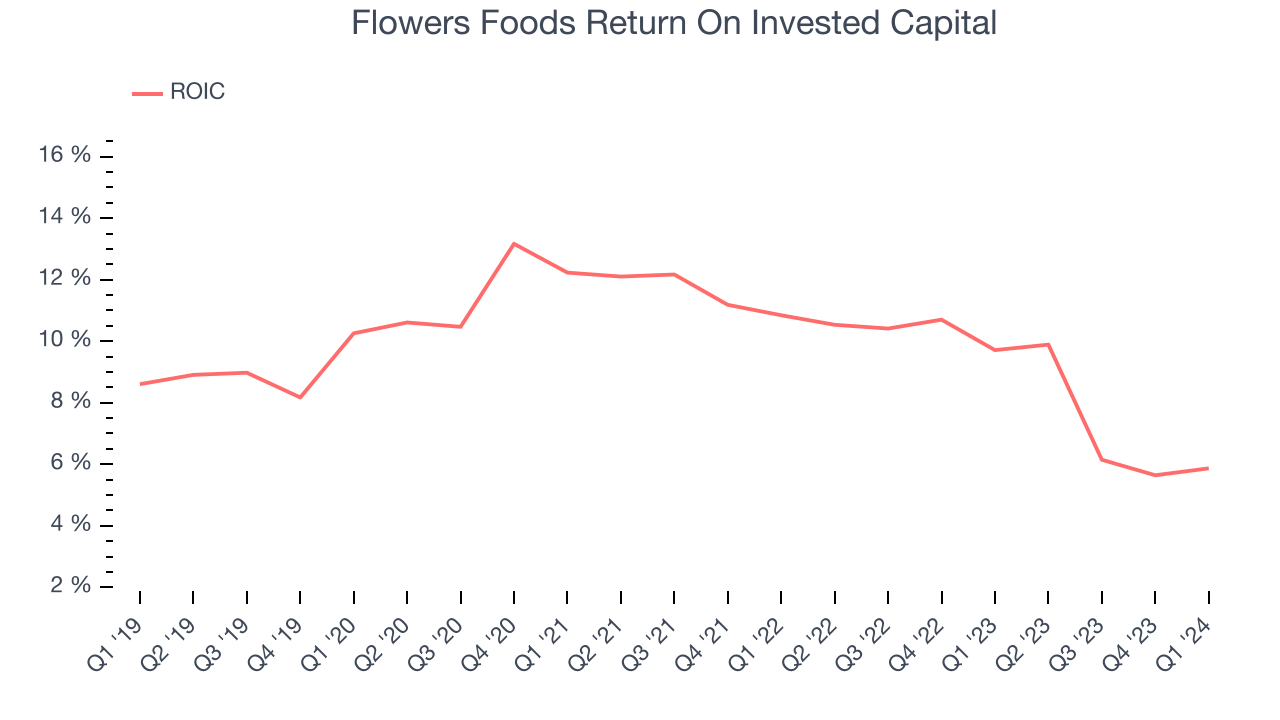
The trend in its ROIC, however, is often what surprises the market and drives the stock price. Unfortunately, Flowers Foods's ROIC averaged 3.5 percentage point decreases over the last few years. Paired with its already low returns, these declines suggest the company's profitable business opportunities are few and far between.
Balance Sheet Risk
Debt is a tool that can boost company returns but presents risks if used irresponsibly.
Flowers Foods reported $15.82 million of cash and $1.04 billion of debt on its balance sheet in the most recent quarter. As investors in high-quality companies, we primarily focus on two things: 1) that a company's debt level isn't too high and 2) that its interest payments are not excessively burdening the business.
With $500.4 million of EBITDA over the last 12 months, we view Flowers Foods's 2.1x net-debt-to-EBITDA ratio as safe. We also see its $6.54 million of annual interest expenses as appropriate. The company's profits give it plenty of breathing room, allowing it to continue investing in new initiatives.
Key Takeaways from Flowers Foods's Q1 Results
Revenue and adjusted EBITDA both missed. While the company reaffirmed full year revenue guidance, it is below expectations at the midpoint. Offsetting this bad news is the fact that the company reaffirmed full year EPS guidance as well, and that came in slightly above Wall Street estimates. Overall, the results were mixed but could have been better. The stock is flat after reporting and currently trades at $25.7 per share.
Is Now The Time?
Flowers Foods may have had a tough quarter, but investors should also consider its valuation and business qualities when assessing the investment opportunity.
We cheer for all companies serving consumers, but in the case of Flowers Foods, we'll be cheering from the sidelines. Its revenue growth has been a little slower over the last three years, and analysts expect growth to deteriorate from here. And while its gross margins are a strong starting point for the overall profitability of the business, the downside is its declining EPS over the last three years makes it hard to trust. On top of that, its projected EPS for the next year is lacking.
Flowers Foods's price-to-earnings ratio based on the next 12 months is 20.4x. While there are some things to like about Flowers Foods and its valuation is reasonable, we think there are better opportunities elsewhere in the market right now.
Wall Street analysts covering the company had a one-year price target of $24.57 per share right before these results (compared to the current share price of $25.70).
To get the best start with StockStory, check out our most recent stock picks, and then sign up to our earnings alerts by adding companies to your watchlist here. We typically have the quarterly earnings results analyzed within seconds of the data being released, and especially for companies reporting pre-market, this often gives investors the chance to react to the results before the market has fully absorbed the information.
